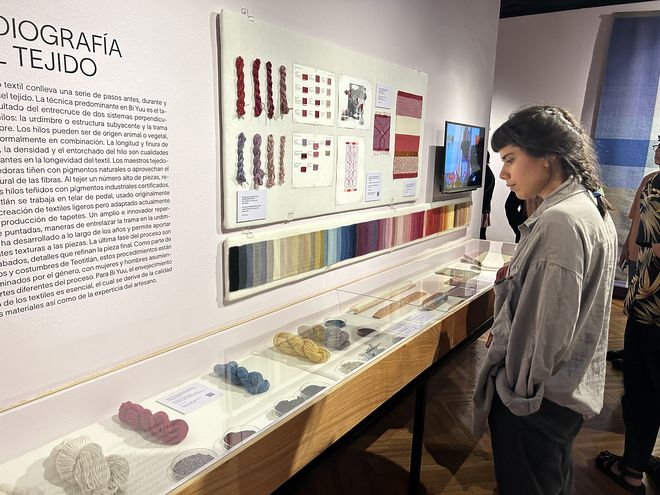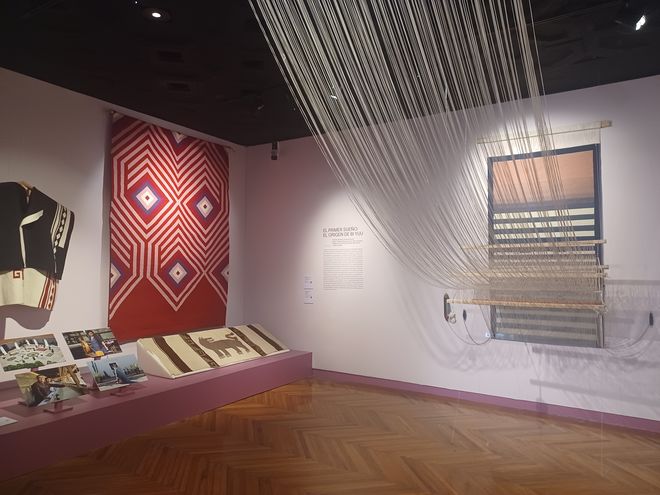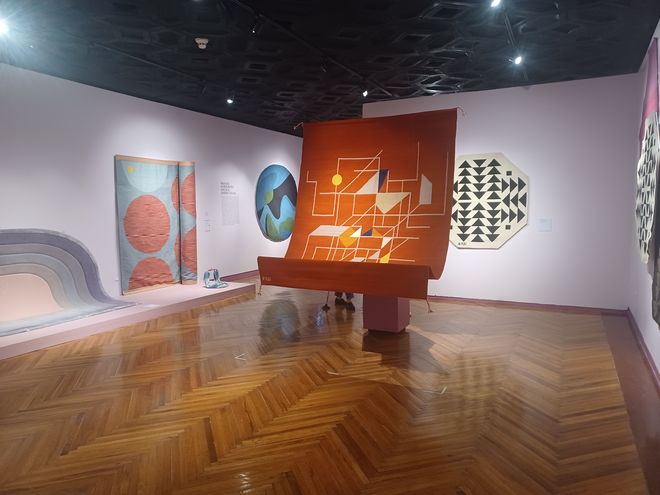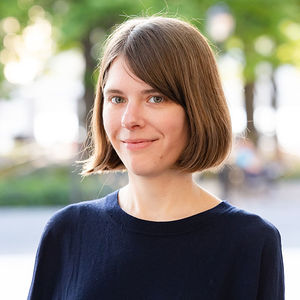
Hilando Rituales: Diez Años Bi Yuu (Spinning Rituals: Ten Years of Bi Yuu) exhibition at the Franz Mayer Museum in Mexico City. Image by Juliana Fagua Arias.
Juliana Fagua Arias is an art historian and curator of Latin American art and material culture. She graduated from Bard Graduate Center’s MA program in 2020. Her qualifying project, an exhibition proposal titled Seafaring Treasures: Latin America and the Transpacific Trade, focused on Latin America’s relationship with Asia during the early modern period. She is currently expanding her research on this topic as a PhD student in the history of art and visual studies department at Cornell University. Current MA student Mackensie Griffin recently sat down with Fagua Arias to discuss her experience curating her first experience as an independent curator.
Mackensie Griffin: Hi Juliana! Congratulations on curating the exhibition Hilando Rituales: Diez Años Bi Yuu (Spinning Rituals: Ten Years of Bi Yuu), which opened at Museo Franz Mayer in Mexico City in May. Could you tell me a bit about the museum and the exhibition?
Juliana Fagua Arias: Sure! The Franz Mayer is a museum that focuses on decorative arts. It’s kind of like the Victoria & Albert Museum of Mexico. It has a huge collection of silver, porcelain, ceramics, textiles, and furniture, mostly from the colonial period, and a lot of material from trade between Mexico and the Philippines that happened between the late 1500s and early 1800s—the Manila Galleon trade. It also has paintings and more typical fine arts, and it is expanding to look at makers and contemporary designers too.
Spinning Rituals celebrates the ten-year history of Bi Yuu, a textile studio based in Mexico City and founded by the designer Marisol Centeno. What makes the design studio unique is that it combines methodologies from design, crafts, and industry. All of its textiles—rugs, tapestries, and table linens— are produced in collaboration with different weaving communities. They work with a predominantly Zapotec Indigenous community in the town of Teotitlán del Valle, Oaxaca, that is well-known for high-quality textiles. Recently Marisol has also started working with a weaving family workshop in Bhadohi, India. She wants to start working with more communities within the city. The studio recently released a new collection of table linens finished by formerly incarcerated women who are reentering society. Marisol is in contact with these women through an agency and they’re now part of the team. Thinking about how design can have a positive impact on society is something that’s a big part of the studio’s mission. It goes beyond just making things that are beautiful. Of course, beauty contributes to a general well-being, but they also want to make sure that the people who work with the studio are positively impacted and benefit from these collaborations.
MG: How is the exhibition organized?
JFA: The exhibition is divided into five sections. In the first section I look at the origin of Bi Yuu and its collaboration with the team in Oaxaca, which makes most of its collections. The people in India and the women in Mexico City are working on specific collections, but for the most part, whenever they have a new collection coming up, the weavers in Teotitlán are going to be in charge of weaving it. So, I look at the meaning of textiles within this Oaxacan community and how textiles are important to the notion of identity held by contemporary Zapotec weavers. They live in a place of constant tension between upholding tradition and a specific way of weaving, but they also have access to the internet, and to technology, and social media. So, I see weaving as a practice that helps them navigate those tensions. I look at what is considered the “traditional” way of being, how it changes, and how it has been adjusted for a design studio.

Hilando Rituales: Diez Años Bi Yuu (Spinning Rituals: Ten Years of Bi Yuu) exhibition at the Franz Mayer Museum in Mexico City. Image by Juliana Fagua Arias.
In the second section, I wanted to have a textile X-ray for those who may not even know what a textile is, in a structural sense. For example, how do you make an image with a textile? I wanted to look more closely at the structure of a textile, the process of weaving itself, and the materials and techniques that these weavers use, so this section considers processes, techniques, and materials. We created an installation piece where half of it is woven, but the other half is just the warps, and you can see an unfinished textile. There is also a display with cochineal, indigo, and other natural pigments that the weavers use to create their color palette. I wanted to discuss the importance of sustainability when you talk about dyeing. The studio works with the Mexican industry a lot too, because even though natural dyeing is very popular— it’s all over Brooklyn, and people are obsessed with it—it’s actually not very sustainable long term because it requires a lot of water. In a region like Oaxaca, which is a desert landscape, you can’t really use water to make dye when you’re in the middle of a drought. So, the studio doesn’t really make large quantities—it’s mostly one-to-one commissions with clients. Or you can go online and buy a Bi Yuu rug or a tapestry and they’ll make it for you. And in some cases, you can even personalize it in different ways, choosing colors, things like that. When they do have big commissions where they need large quantities of textile, they will use aniline instead of natural dyes.
The third section focuses on the importance of experimentation for the studio. They have different spaces to play with the different elements of textiles and dyeing processes. They have experimented with creating hexagonal shapes, things like that. This might seem normal for those studying design, but for people who are used to making things in the same way for centuries, they’re usually not that open to experimenting or to trying new things. This constant experimentation has been a connecting and bonding opportunity, a chance for the designers of the studio and these weavers to collaborate and learn from each other. For instance, one collection was inspired by sacred geometry and this idea of the cosmos and the European Renaissance. And the images in this collection have different geometric shapes, but with volume, so there’s perspective and depth. In weaving, that’s hard to achieve. This section of the exhibition shows their different experiments and how they have enriched the social fabric of the studio, and it also demonstrates the skill and curiosity of both the weavers and the designers.
The fourth section explores the rug as a textile form and its connection to Asia. Pre-Hispanic communities didn’t really use rugs or carpets; they used different objects for the floor, but the studio was inspired by and learned a lot from the communities in South Asia, where the rug as a textile form originated in Persia and in India. There, the connection with the floor is very special. It’s where people pray, eat, and play with their kids. There’s a difference in the way of living and how humans relate to the floor there as opposed to in the West where the floor is thought of as unclean. The studio wanted to elevate the idea of the carpet or the rug to a space of contemplation, a space where you can perform all these daily rituals. This section of the exhibition explores that and the collections that Bi Yuu has developed with the weaving community in Bhadohi. Because the rug and the carpet have had centuries to develop in Asia, weavers there have a technical knowledge that Mexican Indigenous weavers don’t. They approach weaving carpets from a very different perspective. In Mexico, you mostly use looms to weave garments. If you use the same loom to weave a different textile form like a carpet, there will be technical specificities in the object that will show that your loom is not made to weave carpet. The carpet is a flat object, and in India, they usually use a vertical loom or a floor loom so that you can weave these flat shapes. In this section, we3 wanted to show these weavers’ knowledge, tools, technologies, techniques that are specific to creating carpets and rugs. Additionally, this collection they made in India uses the Persian knot, which is not a technique that weavers use in Oaxaca. So, it explores the South Asian conception of the carpet and the rug, and how that has shaped the studio’s approach to the rug.
And then the last section of the exhibition goes into what’s on the horizon for the studio in terms of expanding and strengthening their social impact. How can the studio develop collaborations or connections with groups and communities that positively impact Mexico City? How can it develop certain technologies to make the production processes more sustainable and alleviate their environmental impact? For instance, they created a dyeing oven prototype. This oven was made with certain specifications so that the weavers know exactly how much water they need to use for the dyeing process, and they won’t use more than they need to. That way, they can preserve natural resources.
MG: How is it different from a dye vat?
JFA: It’s more sophisticated than a dye vat. It has a chimney where all the fumes and everything go so that they don’t get in the weavers’ eyes. What I wanted to highlight in the final section is that the studio experimented with creating their own tools and their own technologies to make the dye process more sustainable in general and to make sure that the working environment for these weavers is safer and more hygienic. For instance, most of the weaving in Teotitlán is done by men because the looms are very big, but the studio wanted to have a chance to reconnect with the female weavers in the town. During the pandemic, they created a collection of tapestries that are smaller and meant for female weavers. So, the last section looks at the different ways this studio has made sure to explore the social element of design as a methodology.
There’s also a kind of coda or an epilogue to the exhibition, which is an installation that Bi Yuu made for the exhibition as a tribute to the carpet as a cultural element— an object that is kind of an oasis, a beautiful space where you can perform daily rituals and reconnect with the earth and ground yourself. It has two components—one was woven in India, the other one was woven in Oaxaca, so it’s also a way to bring the two communities that are at the center of the studio together and honor them.
There is a multimedia video installation in another gallery of the museum. It’s made up of twenty-minute videos that show more of the human universe of this studio. It mostly features interviews with the weavers and the designers so visitors can familiarize themselves with how their personal stories, their ideas of happiness, family, home, and the landscapes that they have lived informs their weaving practices and the creative process in the studio. We wanted to create this poetic, intimate environment with three screens and a carpet in the middle where people can sit or lay down and watch the video installation. And the last thing is that we also have a communal loom that will be in the museum, and the idea is that visitors can add a stitch to it. It’s a way for visitors to kind of insert themselves in the story of the studio.

Hilando Rituales: Diez Años Bi Yuu (Spinning Rituals: Ten Years of Bi Yuu) exhibition at the Franz Mayer Museum in Mexico City. Image by Juliana Fagua Arias.
MG: That sounds amazing. Is this the first exhibition that you’ve curated and are you working with other curators on this show?
JFA: It’s my first exhibition as an independent curator, and I was the only one working on the curatorial aspect of it. But I was the Tiffany Foundation curatorial intern at the Metropolitan Museum of Art from 2021 to 2022. And my big project during that time was this installation of Tiffany drawings. I had researched Tiffany commissions in Mexico and in Cuba, and I found some interesting watercolors in the Met’s collection and some photographs of one of the commissions in Cuba. I curated that and it was shown at the Met for about six to eight months. It was a small installation, not an exhibition, but I technically consider that to be my first time curating something for a museum. But yes, this is the first actual exhibition I’ve curated.
MG: That’s very impressive. And you said that Centeno from Bi Yuu was the one to contact you and say, I want you to curate this exhibition?
JFA: We have a friend in common—Christina De Léon, the curator of Latino design at the Cooper Hewitt, who is a BGC PhD candidate. I interned with Christina twice, and we just got along really well together. Marisol initially contacted her to curate the show, but she couldn’t do it for different reasons, so she suggested that I take over the curatorial aspect of the work, and that’s how I ended up curating the show.
MG: Have you been going back and forth between Mexico and doing your PhD at Cornell at the same time?
JFA: I’ve mostly been working remotely on the exhibition. I started working on it in April of last year, when I was still at the Met. For the first week I was in Mexico City, where the studio is based. I had been working with Marisol for all those months and we met weekly online, but that was the first time we met in-person. And I met the design team, who are all women working in Mexico City. I traveled with Marisol to Teotitlán del Valle and met the weavers and the team there. It’s mostly family workshops, so Bi Yuu works with a few specific families, and they have their looms at their houses. I went to their homes and saw their working spaces. It’s a very small town, and I was mostly just hanging out with them in their houses and talking to them about their experience working with Bi Yuu. There are families that have been working with this studio for ten years now, so they have a pretty strong relationship and they know each other’s working dynamics well. It was kind of like getting to know this family that trusts each other and have also gone through all these challenging times together.
MG: And do you feel like the overall experience has been positive and a good learning experience?
JFA: Yes, it has been a really great learning experience. This is my first exhibition, and in working with the Franz Mayer, I learned that my work and my decisions had real life consequences. I did an exhibition proposal for my qualifying project at BGC, and I curated this installation at the Met, but that was all in a very safe bubble. If you messed up, you messed up, and that was fine. Doing an exhibition QP, you can dream as big as you want, but with this experience, I learned that it’s very easy to say, “I want that piece in the show,” but that’s going to have financial consequences. Someone’s going to have to weave it, and someone’s going to have to pay for those materials. Those were the kind of lessons that I learned. And I had to adjust my time and my work rhythm to other teams that needed me to get my work done in order for them to start their work, for example, the people doing the copy editing or translation of the labels. Every decision and everything I had to do had a consequence on someone else’s life, and that was something that I had not experienced so far. It was very challenging but also a great learning experience, and definitely a positive one because the team is not only incredibly talented and creative, they are also masters in their craft. These weavers have been weaving since they were thirteen years old, and Marisol has been working as a leader of this team for ten years now. It’s been incredible and very enriching just learning from their professionalism and their discipline.
MG: Do you feel like there are aspects of your time at BGC that helped you to put together this project?
JFA: Oh yeah. I think what grabbed my attention at first and what made me really interested in this project from the beginning was thinking about the carpet and the rug as a cultural object. I feel like the training at BGC made me approach the themes of this exhibition in a more profound way than maybe a design curator would have. Of course, I don’t know that, but I think because BGC trained me to think about material culture and the importance of objects in daily life and what those objects communicate about the people who use them and make them plus the importance of technique and materiality, I was able to see all those layers in this collection. I think that was also part of what Marisol wanted. She didn’t have a shortage of curators to choose from in Mexico. I think the reason why she decided to go with someone from the outside, someone who is not Mexican (I’m from Colombia) and someone who is not even located in Mexico, but is living and working in New York, was because she was looking for that kind of level of understanding of what the importance of an object is beyond the surface. Typical design shows in Mexico tend to be very formulaic, like this is how designs have evolved throughout time, et cetera. But because she’s done so much research on the cultural importance of carpets and rugs in Asia and Mexico, I think she was looking for a curator who could also analyze the objects in that way, so I think the training at BGC was crucial for that.
MG: Absolutely. What is your dissertation at Cornell focusing on?
JFA: I’m looking at the transpacific trade between Asia and Latin America during the early modern period. Because the Philippines was a Spanish colony beginning in the late sixteenth century, there was this galleon trade that departed from Manila, and they kind of collected all these objects from China, Japan, India, and the Spice Islands. These galleons were laden with textiles, porcelain, spices, ivory, and all of these luxury objects, along with cheaper versions of them that were pretty accessible. They would arrive in Acapulco, Mexico, and then from Acapulco they would be distributed through inland routes, so you had this influx of Asian objects and then the galleons would return to Manila with silver and other goods from the Americas, like cochineal, gold, chocolate cacao. The way that this trade changed and shaped the material culture of both hemispheres of Asia and Latin America is, I think, quite understudied because there’s been a lot of focus on the Atlantic and the connection with Europe, but Latin America had this direct route with Asia early on, and not a lot of people know that. I’m focusing on the Andes and specifically what was then the vice royalty of New Granada, currently Colombia, Venezuela, Panama—the northern part of the Andes and of South America— and looking at those connections with Asia through material culture. That’s why it was especially interesting for me to go deeper into these connections between Mexico and Asia while curating this exhibition. I learned during this project with Marisol that during the 1960s, the Mexican government hired all of these weavers from South Asia and they brought them to a specific town in Mexico to teach the Indigenous weavers how to weave rugs and carpets, so the connection with Asia, particularly through carpets and the rugs, has been going on for a long time and that’s why I wanted a section of the exhibition to be dedicated to that.
MG: That all sounds fascinating. Thank you so much for taking the time to share more about your work and research. Good luck with your dissertation and we can’t wait to see what you do next!
Mackensie Griffin is an MA student at Bard Graduate Center.

